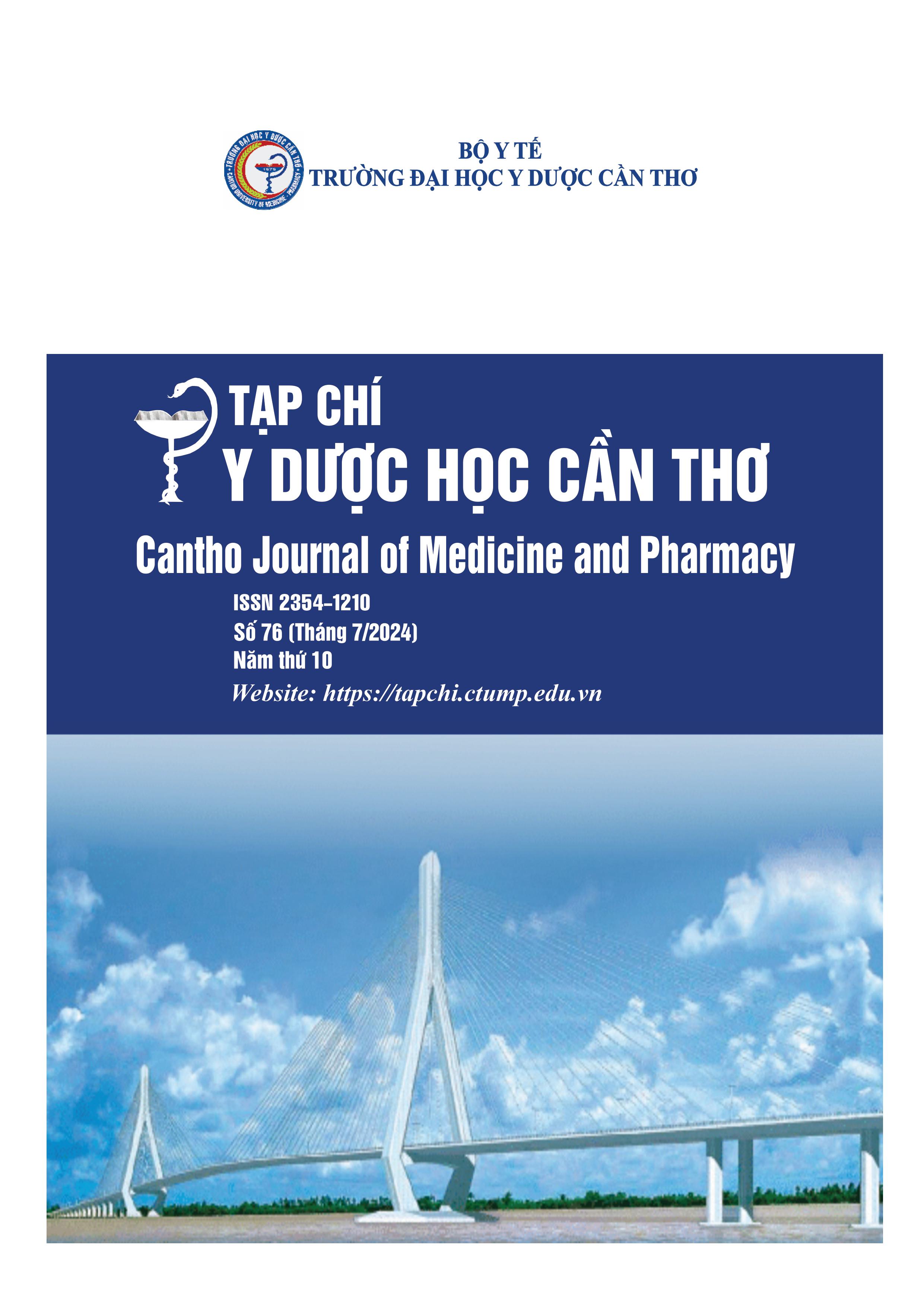GROUP B STREPTOCOCCAL INFECTION IN AN OBSTETRIC POPULATION CHECKED UP AT CAN THO GYNECOLOGY AND OBSTETRICS HOSPITAL IN 2023: THE PREVALANCE AND SOME ASSOCIATED FACTORS
Main Article Content
Abstract
Background: Group B streptococcus (GBS) is a bacterium, which is commonly present in human bodies. Although its colonization is usually harmless to adults, it can lead to dangerous complications and even death in newborns. Therefore, the incidence rate of GBS infection in pregnant women and associated factors need to be carefully concerned. Objectives: To determine the rate of vaginal and rectal GBS infection in pregnant women and some related factors at Can Tho Gynecology and Obstetrics Hospital in 2023. Materials and methods: A cross-sectional descriptive study on 194 pregnant women who agreed to participate in the study at Can Tho Gynecology and Obstetrics Hospital from May to September 2023. Results: The group B streptococcus infection rate in pregnant women at Can Tho Gynecology and Obstetrics Hospital was 26.3%. Living in rural areas (OR=2.06, p=0.037), underlying medical condition (OR=5.07, p=0.031), history of vaginitis (notable for “Not acquired” and “Ongoing treatment” with OR=3.42, p=0.007 and OR=6.13, p=0.032, respectively) and white blood cells in urine (OR=6.16, p=0.046) were factors related to the rate of GBS infection. Conclusion: The incidence rate of GBS in pregnant women was high. Factors that increase the risk of GBS infection are place of residence (rural areas), underlying medical condition, not acquired and ongoing treatment vaginitis, and presence of white blood cells in urine.
Article Details
Keywords
Pregnant women, GBS, vaginitis, rural areas
References
2. P. T. Trang, P. T. T. Hiền, Đ. T. Đạt, and D. T. T. Giang. Tỷ lệ mang liên cầu nhóm B và kết quả thai kỳ ở sản phụ sinh tại Bệnh viện Phụ sản Hà Nội. Tạp chí Khoa học và Công nghệ Việt Nam. 2023. vol. 65, no. 7, DOI: 10.31276/VJST.65(7).08-11.
3. Lương Phong Nhã, Lê Hồng Thịnh, Huỳnh Thanh Liêm và Nguyễn Xuân Thảo. Nghiên cứu tình hình thai phụ nhiễm Streptococcus nhóm B âm đạo- trực tràng, các yếu tố liên quan và kết quả điều trị dự phòng lây truyền từ mẹ sang con tại Bệnh viện Phụ sản thành phố Cần Thơ năm 2019. Tạp chí Y dược học Cần Thơ. 2023. 40, 223-229, https://tapchi.ctump.edu.vn/index.php/ctump/article/view/825.
4. N. J. Russell et al. Maternal colonization with Group B Streptococcus and serotype distribution worldwide: systematic review and meta-analyses. Clinical infectious diseases. 2017. vol. 65, no. suppl_2, pp. S100-S111, doi: 10.1093/cid/cix658.
5. Slotved HC, Hoffmann S. The Epidemiology of Invasive Group B Streptococcus in Denmark From 2005 to 2018. Front Public Health. 2020 Mar 10. 8,40, doi: 10.3389/fpubh.2020.00040. PMID: 32211361; PMCID: PMC7076979.
6. Navarro-Torné A, Curcio D, Moïsi JC, Jodar L. Burden of invasive group B Streptococcus disease in non-pregnant adults: A systematic review and meta-analysis. PLoS One. 2021 Sep 30. 16(9), e0258030, doi: 10.1371/journal.pone.0258030.
7. Evans JJ, Klesius PH, Gilbert PM, Shoemaker CA, Al Sarawi MA, Landsberg J, et al. Characterization of b-haemolytic Group B Streptococcus agalactiae in culture seabream, Sparus auratus L., and wild mullet, Liza klunzingeri (Day), in Kuwait. J Fish Dis. 2002. 25, 505–513, doi: 10.1046/j.1365-2761.2002.00392.x.
8. Berridge BR, Bercovier H, Frelier PF. Streptococcus agalactiae and Streptococcus difficile 16S23S intergenic rDNA: genetic homogeneity and species-specific PCR. Vet Microbiol. 2001 Jan 26. 78(2):165-73, doi: 10.1016/s0378-1135(00)00285-6.
9. B. Foxman, B. Gillespie, S. Manning và C. Marrs. Risk factors for group B streptococcal colonization: potential for different transmission systems by capsular type. Annals of epidemiology. 2007. Vol.17, no.11, 854-862, doi: 10.1016/j.annepidem.
10. Phan Thuận. Biến đổi cơ cấu xã hội- nghề nghiệp ở đồng bằng sông Cửu Long. VNU Journal of Science: Policy and Management Studies. 2019. Vol. 35, No. 2:96-104.
11. Tăng Xuân Hải và Quế Anh Trâm. Nghiên cứu thực trạng và một số yếu tố liên quan với nhiễm liên cầu khuẩn nhóm B đường sinh sản ở phụ nữ có thai tuần thứ 35 đến tuần thứ 37 tại Nghệ An năm 2019. Tạp chí Y học Cộng đồng. 2022. Tập 63, số 3, DOI: https://doi.org/10.52163/yhc.v63i3.323
12. Võ Thị Cẩm Nhung, Ngô Thị Kim Phụng, Phạm Tấn Lộc. Tỷ lệ nhiễm Streptococcus nhóm B ở thai phụ đái tháo đường thai kỳ và các yếu tố liên quan tại Bệnh viện Nhân dân Gia Định. Tạp chí Y học Việt Nam. 2022. 520, số chuyên đề Bệnh viện Nhân dân Gia Định, 251-260.
13. Huỳnh, H. T., Lâm, Đức T., Trịnh, T. H. C., & Trần, N. D. Mối liên quan giữa đái tháo đường thai kỳ và nhiễm liên cầu nhóm b trên thai phụ tại Bệnh viện Quốc tế Phương Châu Cần Thơ. Tạp Chí Y học Việt Nam. 2023. 532(2), https://doi.org/10.51298/vmj.v532i2.7647
14. P. T. Lý, N. Q. Tuấn, and T. M. Linh. Tỷ lệ mang liên cầu khuẩn nhóm B ở 35–37 tuần thai kỳ và hiệu quả của kháng sinh dự phòng lây nhiễm trước sinh. Tạp chí Phụ sản. 2020. Tập. 18, số. 3, 19-26, DOI:10.46755/vjog.2020.3.1140
15. C. M. Leclair, M. F. Goetsch, H. Carpentier, and J. T. J. J. o. l. g. t. d. Jensen. Group B Streptococcus: prevalence in a non-obstetric population. J Low Genit Tract Dis. 2010. vol. 14, no. 3, 162, doi: 10.1097/LGT.0b013e3181d3d40f.


